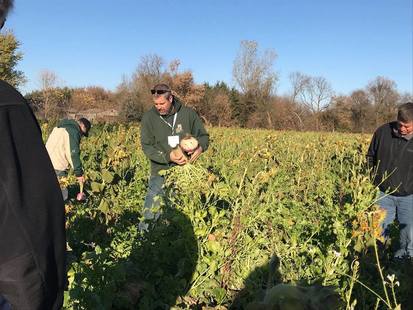|
As part of the LWV Lake Michigan annual meeting at the State of Lake Michigan conference in Green Bay Nov 7-9, LWV UMRR board member Judy Beck (LWV Glenview, IL) toured demonstration farms in Northeastern Wisconsin’s Silver Creek watershed. These farms are employing best management practices to reduce the amount of phosphorus and sediment that is lost from their farms into Green Bay, a water body with a large ‘dead zone’. Following is the writeup from that tour, which documents very promising results from this work. Supported by funding from the Great Lakes Restoration Imitative (GLRI), the US Geological Survey (USGS) has partners with four Fox Demo Farms to measure sediment and nutrient loss in surface and sub-surfaces runoff at edge-of-field (EOF) monitoring sites. Based on preliminary data collected by the USGS, monitoring at one farm in the project, Brickstead Dairy’s monitoring site in the Silver Creek watershed shows that there have been significant reductions in nutrient and sediment loss. Read more about the project at this link.  The site was monitored in crop years 2014, 2015 and 2016. This monitoring showed that an average of 2000 lb/acre of sediment and nearly 4 lb/acre of phosphorus were measured in surface runoff. In the fall of 2016, cover crops were planted and then in 2017 no-till farming practices were employed. For water year 2017 to date (Oct 1, 2016 to Sept 19, 2017) sediment losses were about 1000 lb/acre. This is seen as an indication that the switch to no-till with cover crops could be reducing sediment losses. Since about 80% of the phosphorus lost from ‘typical’ soils in the area using ‘typical’ farming practices is tied in with the sediment, reducing sediment loss will also reduce the loss of phosphorus. Phosphorus is the limiting element in Green Bay – the algae that cause the dead zone need phosphorus to multiply. For a very graphic depiction of runoff, check this video. Left, tillage radishes used as cover crop. By planting cover crops and using no-till farming practices, producers benefit from having to spend fewer hours in the field and find cost savings due to reduced cost of farming inputs (fuel, equipment, fertilizers and pesticides). Soil health is also improved with increased water infiltration rates, less erosion and improved soil biology. By limiting sediment loss, phosphorus discharge to Green Bay is reduced and less algae growth will take place, a mutually-beneficial win-win for the environment and the farmers’ bottom line.
0 Comments
Leave a Reply. |
| LWV Upper Mississippi River Region | UMRR blog |
 RSS Feed
RSS Feed